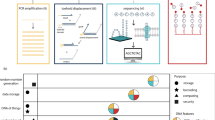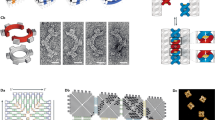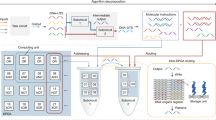Abstract
Manufacturing processes for biological molecules in the research laboratory have failed to keep pace with the rapid advances in automization and parellelization1,2,3. We report the development of a digital-to-biological converter for fully automated, versatile and demand-based production of functional biologics starting from DNA sequence information. Specifically, DNA templates, RNA molecules, proteins and viral particles were produced in an automated fashion from digitally transmitted DNA sequences without human intervention.
This is a preview of subscription content, access via your institution
Access options
Access Nature and 54 other Nature Portfolio journals
Get Nature+, our best-value online-access subscription
$29.99 / 30 days
cancel any time
Subscribe to this journal
Receive 12 print issues and online access
$209.00 per year
only $17.42 per issue
Buy this article
- Purchase on Springer Link
- Instant access to full article PDF
Prices may be subject to local taxes which are calculated during checkout


Similar content being viewed by others
References
Rauch, S., Dallinger, M., Dallasega, P. & Matt, D.T. Sustainability in manufacturing through distributed manufacturing systems (DMS). Procedia CIRP 29, 544–549 (2015).
Srai, J.S. et al. Distributed manufacturing: scope, challenges and opportunity. Int. J. Prod. Res. 54, 6917–6935 (2016).
Pearce, J.M. Materials science. Building research equipment with free, open-source hardware. Science 337, 1303–1304 (2012).
Jones, R. et al. RepRap—the replicating rapid prototyper. Robotica 29, 177–191 (2011).
Pearce, J.M., Anzalone, N.C. & Heldt, C.L. Open-source wax RepRap 3-D printer for rapid prototyping paper-based microfluidics. J. Lab. Autom. 21, 510–516 (2016).
Gottschalk, U., Brorson, K. & Shukla, A.A. The need for innovation in biomanufacturing. Nat. Biotechnol. 30, 489–492 (2012).
Gibson, D.G. et al. Creation of a bacterial cell controlled by a chemically synthesized genome. Science 329, 52–56 (2010).
Hutchison, C.A. III et al. Design and synthesis of a minimal bacterial genome. Science 351, aad6253 (2016).
Smith, H.O., Hutchison, C.A. III, Pfannkoch, C. & Venter, J.C. Generating a synthetic genome by whole genome assembly: phiX174 bacteriophage from synthetic oligonucleotides. Proc. Natl. Acad. Sci. USA 100, 15440–15445 (2003).
Perez-Pinera, P. et al. Synthetic biology and microbioreactor platforms for programmable production of biologics at the point-of-care. Nat. Commun. 7, 12211 (2016).
Pardee, K. et al. Portable, on-demand biomolecular manufacturing. Cell 167, 248–259.e12 (2016).
Li, J. et al. Synthesis of many different types of organic small molecules using one automated process. Science 347, 1221–1226 (2015).
Khan, K.H. DNA vaccines: roles against diseases. Germs 3, 26–35 (2013).
Moreland, L., Bate, G. & Kirkpatrick, P. Abatacept. Nat. Rev. Drug Discov. 5, 185–186 (2006).
Narayanan, R., Kuppermann, B.D., Jones, C. & Kirkpatrick, P. Ranibizumab. Nat. Rev. Drug Discov. 5, 815–816 (2006).
Hudis, C.A. Trastuzumab—mechanism of action and use in clinical practice. N. Engl. J. Med. 357, 39–51 (2007).
Gibson, D.G. et al. Enzymatic assembly of DNA molecules up to several hundred kilobases. Nat. Methods 6, 343–345 (2009).
Geall, A.J. et al. Nonviral delivery of self-amplifying RNA vaccines. Proc. Natl. Acad. Sci. USA 109, 14604–14609 (2012).
Dormitzer, P.R. et al. Synthetic generation of influenza vaccine viruses for rapid response to pandemics. Sci. Transl. Med. 5, 185ra68 (2013).
Stech, M.K.S. & Kubick, S. Cell-free synthesis meets antibody production: a review. Antibodies 4, 12–33 (2015).
Grote, A. et al. JCat: a novel tool to adapt codon usage of a target gene to its potential expression host. Nucleic Acids Res. 33, W526–W5331 (2005).
Acknowledgements
The authors thank C. Beard, S. Farah, O. Fetzer, K. Han, C. Hutchison, A. Lee, D. Lomelin, A. Nandi, T. Newman-Lehman, T. Peterson, S. Riedmuller, J. Robinson, H. Smith, J. Strauss, J. Thielmier, L. Warden, M. Winstead, and A. Witschi for their contributions to this work, and the US Defense Advanced Research Projects Agency (contract HR0011-13-C-0073 for D.G.G. and J.C.V.) for funding aspects of this work.
Author information
Authors and Affiliations
Contributions
J.C.V. and D.G.G. conceived the study; K.S.B., K.K., J.G., H.G., B.H., K.I.K. and D.G.G. designed experiments and analyzed data; K.S.B., K.K., M.F. and D.G.G. performed experiments; and K.S.B., K.K., J.C.V. and D.G.G. wrote the paper.
Corresponding author
Ethics declarations
Competing interests
The authors are or have been employed by Synthetic Genomics, Inc. (SGI), a privately held company, and may hold stock or stock options. SGI has filed provisional applications with the US Patent and Trademark Office on aspects of this research (PCT/US2013/055454).
Integrated supplementary information
Supplementary Figure 1 Prototype of the digital-to-biological converter (DBC).
Components that constitute the DBC are marked as indicated in the following equipment list.
Supplementary Figure 2 Route map of synthesis of a biological in DBC.
Schematic of the sequence of processes that are automated to occur on the DBC subsequent to recognizing the oligonucleotide synthesis file and the name of the instruments used in these processes are shown.
Supplementary Figure 3 Importance of error-correction reaction to produce functional DNA amplicons.
(a) Genome of the phage ΦX174, was synthesized in vitro from oligonucleotides while including or not including an error-correction step. Error-corrected genome produced many more functional viral particles (as demonstrated by plaque formation on susceptible E. coli strain HF4704, Supplementary Methods), than the genome that was not subjected to an error-correction step during synthesis. (b) In vitro coupled transcription-translation reaction (PURExpress, New England Biolabs) was used to produce green fluorescent protein (GFP) from DNA templates that were error-corrected or not subjected to the error-correction reaction. A no template control was included. Relative fluorescence units (RFU) (Ex: 480nm; Em: 510nm) was measured every 20min after the first 60min of incubation at 37˚C. A consistent lag in the GFP yield was observed when a non-error corrected template was used (green curve vs orange curve).
Supplementary Figure 4 Optimizing protein production conditions for the DBC.
T7- or tac- promoter driven- green fluorescent protein (GFP) encoding template with or without the T7 terminator was transcribed and translated using PURExpress in vitro Protein Synthesis Kit (New England Biolabs) or E. coli S30 Extract System for Linear Templates (Promega). Transcription-translation reactions were incubated for two hours at 37˚C before measuring relative fluorescence units (RFU) (Ex: 480nm; Em: 510nm). (a) To avoid DNA purification on the DBC, unpurified DNA amplicon directly from a PCR was tested for the production of protein, when incubated with in vitro coupled transcription-translation systems. 3-6 μl of unpurified T7-GFP template was used in 25 μl of PURExpress and the RFUs were recorded. (b) Two in vitro transcription-translation systems were compared, PURExpress in vitro Protein Synthesis Kit (New England Biolabs) or E. coli S30 Extract System for Linear Templates (Promega), for the production of GFP using none or 3 μl of unpurified PCR product carrying T7 or the tac promoter. (c) Robustness of the PURExpress system was tested by pre-incubating the reaction mix under sub-optimal conditions such as -20˚C or 4˚C for 16 hours prior to the coupled transcription-translation reaction for the ease-of-use in the DBC. Temperature conditions were tested with T7-promoter driven GFP templates with or without the T7-terminator to assess the importance of the T7-terminator regulatory element.
Supplementary Figure 5 Visualizing GFP produced by DBC.
DNA template carrying encoding GFP with T7 -promoter and -terminator as regulatory elements was transcribed and translated using the PURExpress system. A negative control for the in vitro coupled transcription-translation reaction was included with no DNA template added to the reaction. These two reactions were tested for protein production on the Typhoon Imager (Amersham Biosciences) using the Green laser setting along with a GFP standard (10 μg) purchased from Vector Laboratories. GFP fluorescence from the DBC sample is indicative of the production of properly-folded and functional GFP.
Supplementary Figure 6 Production of polypeptides constituting antibodies on the DBC.
Lucentis (a) and Herceptin (b) were synthesized by assembling a tac-promoter driven bi-cistronic light and heavy chain ORFs and translating this construct using the E. coli S30 Extract System for Linear Templates (Promega). Translation was done in the presence of FluoroTect™ GreenLys in vitro Translation Labeling System (Promega), which enabled fluorescence-based visualization of the protein. Lucentis (a) is a combination of two polypeptides of very similar molecular weight (24 kDa and 25 kDa), which could not be successfully resolved with our system. In both (a) and (b), the control and the antibody lanes were contrasted more than the protein marker lane to visualize the proteins produces.
Supplementary Figure 7 Verifying H7 assembly into an RNA replicon backbone using RT-PCR.
Hemagglutinin antigen H7 was assembled from oligo nucleotides in the DBC and ligated into a self-amplifying RNA replicon based on the genome of the Venezuelan equine encephalitis virus before transcription. To verify the presence of H7 coding region within the RNA replicon mRNA, an oligo dT primer was used in RT-PCR (NEB ProtoScript, with or without RT, +/-) to convert the RNA to cDNA. cDNA, thus generated, was subsequently used as a PCR template for PCR with primers flanking the H7 coding region (1790bp).
Supplementary Figure 8 Immunofluorescence analysis (IFA) of Vero cells transfected with H7 replicon RNA synthesized on the DBC.
Cells were fixed and immuno-stained with an anti-H7 primary antibody and Alexa Flour 488 secondary antibody. (a) Bright-field image of H7 Replicon transfected Vero cells. (b) IFA of H7 Replicon transfected cells showing H7 specific expression. (c) Overlay of H7 and DAPI channels. (d) Overlay of H7, DAPI, and bright-field channels.
Supplementary Figure 9 GC flux of the various DNA templates synthesized on the DBC.
Each of the nine DNA templates (listed on Supplementary Table 4) assembled on the DBC, was subjected to GC-flux analysis using GPMiner (http://gpminer.mbc.nctu.edu.tw/) across the entire length of the template using a 60-nucleotide window. The number of windows (X-axis) was plotted against the GC% of the windows (Y-axis).
Supplementary Figure 10 Biological material synthesized on the DBC.
Full-length DNA and protein gels corresponding to those in Figure 2 are shown. The expected DNA and protein products are indicated by arrows.
Supplementary information
Supplementary Text and Figures
Supplementary Figures 1–10 (PDF 1236 kb)
Supplementary Tables
Supplementary Tables 1–12 (PDF 241 kb)
Supplementary Codes
Oligonucleotide Designer Script (PDF 226 kb)
Supplementary Data
Amplicon Sequencing (PDF 23955 kb)
Rights and permissions
About this article
Cite this article
Boles, K., Kannan, K., Gill, J. et al. Digital-to-biological converter for on-demand production of biologics. Nat Biotechnol 35, 672–675 (2017). https://doi.org/10.1038/nbt.3859
Received:
Accepted:
Published:
Issue Date:
DOI: https://doi.org/10.1038/nbt.3859
This article is cited by
-
Breaking the mold with RNA—a “RNAissance” of life science
npj Genomic Medicine (2024)
-
Streamlined and on-demand preparation of mRNA products on a universal integrated platform
Microsystems & Nanoengineering (2023)
-
Automated high-throughput genome editing platform with an AI learning in situ prediction model
Nature Communications (2022)
-
A framework to efficiently describe and share reproducible DNA materials and construction protocols
Nature Communications (2022)
-
Cell-free gene expression: an expanded repertoire of applications
Nature Reviews Genetics (2020)



